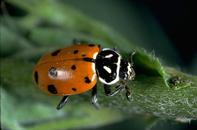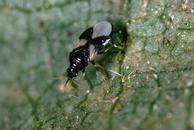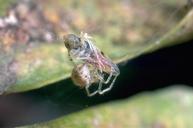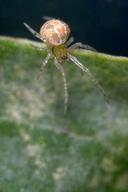|
|
Grape >
Year-Round IPM Program >
Rapid Shoot Growth
> Leafhopper Natural Enemies
Grape (Table)
Leafhopper Natural Enemies
On this page
- Parasitic wasp, Anagrus spp.
- Convergent lady beetle
- Minute pirate bugs
|
- Green lacewing
- Predaceous mite, Anystis agilis
- Agrarian sac spider
|
- Funnel weaver spider
- Diurnal cobweb weaver
|
When sampling for leafhoppers examine leaves with a hand lens for the
presence of parasitized eggs. Look for predators, too. Names link to more
information on identification and biology.
Click on photos to enlarge
| Parasitic
wasp, Anagrus
spp.: Look for parasitization in grape leafhopper eggs. |

Nonparasitized grape leafhopper egg inserted into leaf tissue
appears translucent-white.
|

Adult female wasp, Anagrus spp., is a parasite of leafhopper eggs. |

Parasitized grape leafhopper egg. Eggs parasitized by Anagrus spp. turn red.
|

Anagrus spp. emerges from an egg (right—see emergence
hole); nonparasitized egg (left). |
| More leafhopper natural enemies |

Convergent lady beetle (larva)
Identification tip: Larvae are elongate with long legs, and resemble
tiny alligators.
|

Convergent lady beetle (adult)
Identification tip: Adults have orange to red forewings and
black spots (or no spots). The black thorax has two converging white
lines and a white margin. |

Minute pirate bugs
Identification tip: Adults are small, about 1/12 to 1/5 inch
long, oval, black, or purplish with white markings, and have a triangular
head.
|

Green lacewing (larva)
Identification tip: The larva is pale with dark markings and
looks like a tiny alligator.
|

A predaceous mite
Identification tip: Anystis agilis is an orange mite with
hairs.
|
| Spiders |

Agrarian sac spider
Identification tip: This spider has a pale, yellow to greenish body with
a dark-brown to black carapace and dark legs (most common spider in San Joaquin
Valley vineyards).

Here it wraps up a variegated leafhopper.
|

Funnel weaver spider
Identification tip: This spider has a dark-gray band on each
side of its abdomen. |

Diurnal cobweb weaver (comb-footed spider)
Identification tip: Look for this spider on the
underside of leaves waiting for prey, such as leafhoppers.
|
Top of page
|


